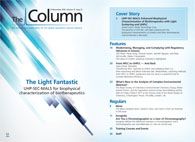What’s New in the Analysis of Complex Environmental Matrices?
The Royal Society of Chemistry’s Environmental Chemistry Group, Water Science Forum, and the Separation Science Group Joint Meeting will be held on Friday 3 March 2017 at the Science Suite of the Royal Society of Chemistry, in Burlington House, Piccadilly, London, UK.
Photo Credit: Freedom-Photo/Shutterstock.com

The Royal Society of Chemistry’s Environmental Chemistry Group, Water Science Forum, and the Separation Science Group Joint Meeting will be held on Friday 3 March 2017 at the Science Suite of the Royal Society of Chemistry, in Burlington House, Piccadilly, London, UK.
The analysis of environmental matrices, such as water, sediments, soils, and biota, is often demanding and challenging for the analytical chemist because of matrix effects and the myriad of substances that can be present in the sample. In recent years, considerable progress has been made in this area - namely, the development of robust, reproducible sample extraction and clean-up methods based on liquid- or solidâphase techniques and also the availability of more rugged instruments that allow the direct injection of dirty samples. This one-day Royal Society of Chemistry Meeting - What’s New In The Analysis of Complex Environmental Matrices? - will be held at Burlington House in London in Friday 3 March 2017, will address some of the demanding issues surrounding environmental analysis. The event is jointly organized by three of the Society’s special interest groups (Environmental Chemistry Group, Separation Science Group, and Water Science Forum), and is the third in sequence of highly successful biennial conferences. The meeting brings together a number of national and two international experts from both academia and industry.
A major topical theme of the meeting is the monitoring and screeningâtype analyses of a wide range of both regulatory and emerging pollutants (such as pharmaceuticals and personal care products) in water. These aspects are addressed by Leon Barron (King’s College London, UK) and Barbara KasprzykâHordern (University of Bath, UK), who will discuss how the profiling or screening of complex water samples using various liquid chromatography–mass spectrometry (LC–MS) methods can be used forensically (for the detection of illicit substances and explosive residues for example) or in sewage epidemiology studies. The latter approach involves the collection of samples from wastewater treatment plants. These samples are then used to look for both pharmaceutical residues and substances indicative of the lifestyle of those persons served by the works.
This theme is continued in the presentations from Andrew Sweetman (Lancaster University, UK) and our keynote speaker, Jaroslav Slobodnik (Environmental Institute, Slovak Republic). The former will highlight the use of alternative water monitoring techniques such as passive sampling devices for measuring both metals and organic pollutants and how these tools might be incorporated in regulatory water quality programmes, such as the European Union’s Water Framework Directive. How mass spectrometry techniques can be used for the screening of currently unregulated pollutants in water, and how this information can improve risk assessments will be picked up by the keynote speaker. He will use examples from the recent River Danube River Basin Survey to show the power of this approach. The last talk under the “water theme” will be given by Gavin Mills (Severn Trent Ltd., UK), who will discuss how new highly sensitive detectors can be used to investigate taints, taste, and odour issues in drinking water. This is often a serious problem for many water supply companies because the compounds causing these issues can often be sensed by consumers at ultratrace concentrations.
Two sessions will cover advances in spectrometric detectors and their potential use in environmental investigations. Colin Creaser (Loughborough University, UK) will look at the use of ion mobility as a complementary tool to give additional information on the composition of complex samples and how it can be applied alongside more conventional detectors. Marvin Shaw (University of York, UK) will look at selected ion flow tube mass spectrometry (SIFT)-MS and how this new method can be used for the rapid analysis of volatile organic substances in ambient samples.
Stuart Harrad (University of Birmingham, UK) will discuss the issues surrounding the use of brominated flame retardants in various consumer products and some of the risks to human health that these chemicals present. This topic is aligned to our second keynote speaker, Jacob de Boer (Vrije Universiteit Amsterdam, Netherlands), who will cover indoor human exposure (for example, dust) to a range of substances and how direct probe time-of-flight mass spectrometry can be used as a rapid analytical method for this purpose.
In addition to the nine presentations, there will an exhibition where a number of instrument manufacturers and suppliers of laboratory consumables will be presenting.
E-mail: roger.reeve@sunderland.ac.uk
Website:http://www.rsc.org/events/detail/24280/whats-new-in-the-analysis-of-complex-environmental-matrices

Characterizing Plant Polysaccharides Using Size-Exclusion Chromatography
April 4th 2025With green chemistry becoming more standardized, Leena Pitkänen of Aalto University analyzed how useful size-exclusion chromatography (SEC) and asymmetric flow field-flow fractionation (AF4) could be in characterizing plant polysaccharides.









